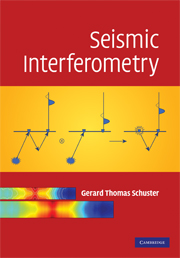Book contents
- Frontmatter
- Contents
- Preface
- 1 Introduction
- 2 Reciprocity equations of convolution and correlation types
- 3 VSP → SWP correlation transform
- 4 VSP → SSP correlation transform
- 5 VSP → SSP convolution transform
- 6 SSP → SSP correlation transform
- 7 VSP → VSP correlation transform
- 8 SSP → VSP → SWP transforms
- 9 Traveltime interferometry
- 10 Stochastic interferometry
- 11 Interferometric source estimation
- 12 Body wave earthquake interferometry
- References
- Index
3 - VSP → SWP correlation transform
Published online by Cambridge University Press: 15 October 2009
- Frontmatter
- Contents
- Preface
- 1 Introduction
- 2 Reciprocity equations of convolution and correlation types
- 3 VSP → SWP correlation transform
- 4 VSP → SSP correlation transform
- 5 VSP → SSP convolution transform
- 6 SSP → SSP correlation transform
- 7 VSP → VSP correlation transform
- 8 SSP → VSP → SWP transforms
- 9 Traveltime interferometry
- 10 Stochastic interferometry
- 11 Interferometric source estimation
- 12 Body wave earthquake interferometry
- References
- Index
Summary
This chapter derives the vertical seismic profile to single well profile correlation transform, i.e., the VSP → SWP transform listed in the classification matrix in Figure 1.10. The transform estimates the SWP Green's function G(B|A) from the VSP Green's functions G(A|x) and G(B|x), where x is near the free surface and B and A are along the well in Figure 3.1. The practical benefit of this mapping is that the source is redatumed to be closer to the target near the VSP well, hence a better image resolution is possible. To clarify the physical meaning of this transform, the stationary phase method is used for analyzing reflections in a two-layer reflector model. Examples with both synthetic and field data illustrate the effectiveness of the VSP → SWP transform when applied to VSP traces.
Introduction
A far-field variant of the VSP → SWP correlation transform was first proposed by Bakulin and Calvert (2004), Calvert et al. (2004), and Bakulin and Calvert (2006) for VSP data. The purpose was to redatum VSP data so that both the sources and receivers were below the complex overburden and could be closer to the target body. They also suggested the extra step of deconvolving the downgoing wavefield recorded by the downhole geophones to reduce unwanted artifacts in the redatumed data. Versions of this procedure have been employed for interferometric imaging of salt flanks using filtered cross-correlograms (Hornby et al., 2006; Hornby and Yu, 2006; He, 2006) and autocorrelograms (Willis et al., 2006), and for redatuming crosswell data (Minato et al., 2007).
- Type
- Chapter
- Information
- Seismic Interferometry , pp. 61 - 85Publisher: Cambridge University PressPrint publication year: 2009



